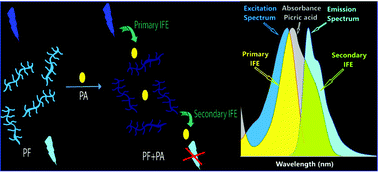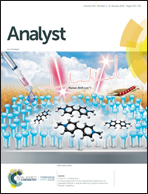“Receptor free” inner filter effect based universal sensors for nitroexplosive picric acid using two polyfluorene derivatives in the solution and solid states†
Abstract
Two “receptor-free” blue fluorescent conjugated polymers (CPs) of fluorene namely 9,9-bis(6-bromohexyl)-2-phenyl-9H-fluorene (PF1) and 9,9-bis(6-bromohexyl)-9H-fluorene (PF2) were synthesized using Suzuki cross coupling polymerization and oxidative coupling polymerization methods in high yields and well characterized by gel permeable chromatography, NMR, UV-vis, fluorescence and time-resolved photoluminescence (TRPL) spectroscopy. Both CPs explicitly recognized nitroexplosive picric acid (PA) and displayed a fluorescence quenching response in solution and on a solid support via the Inner Filter Effect (IFE) mechanism. Both CPs were highly selective and sensitive towards PA with high quenching constant values (Ksv) of 5.1 × 104 M−1 and 5.0 × 104 M−1 and remarkably low limit of detection (LOD) values of 110 nM and 219 nM. Contact mode detection of PA was also accomplished using economical and transportable fluorescent paper test strip devices for on-site sensing, which detect a minimum of 22.9 femtograms of PA. The IFE mechanism for PA sensing (or for other analytes) is an interesting concept that can detect PA by just having blue fluorescence. Therefore, careful experiments for IFE correction were performed herein for PA detection to observe ∼77% suppression efficiency due to the IFE. These studies provide fundamentally important information on the IFE based mechanism for the detection of various analytes.



 Please wait while we load your content...
Please wait while we load your content...